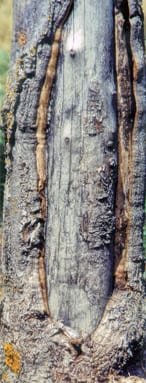Ceratocystis fimbriata (fungus)
Trees affected include Alder, aspen, magnolia, maple, mulberry, sweet gum, and sycamore.
Found throughout United States and southern Canada.
Poor sites, wounding, nutrient abnormalities, spring moisture contibute.
There are sunken or flattened, lens-shaped canker at base of petiole or needle scars, causing a crook in twigs, wilting above the canker; leaves sparse, yellowing, stunted and dieback. Stem infection with black spots in bark and surrounding sticky cankers, with dark staining around cankers. Bark may slough and crack, especially on sycamore. Inner bark with red-brown to blue-black discoloration. May be fatal.
The Perithecia develop at bases of petioles due to infection of leaves. Fungus may move down into stem or concentrate around stem wounds. Sticky ascospores develop during moist spring weather and are released to produce new infections. Spores are airborne or carried by insects and pruning tools.


